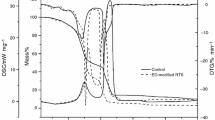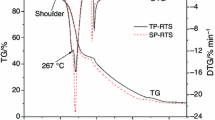Abstract
In this paper, first the MP-modified reconstituted tobacco sheet (RTS) was prepared by a paper-making process. Thermogravimetric analysis coupled to Fourier transform infrared spectrometer (TG-FTIR) had been used to investigate the influences of melamine phosphate (MP) on the thermal decomposition and the formation of evolved volatile products of RTS. TG-FTIR results illustrated that the incorporation of MP into RTS could retard the thermal decomposition of the major components of RTS and meanwhile lead to the formation of more thermally stable char. Moreover, the main gases released during the pyrolysis of RTS and MP-modified RTS were H2O, CO2, CO, NH3, carbonyl compounds, alcohols, phenols, alkanes, and alkenes. The presence of MP changed the formation of evolved volatile products of RTS obviously. The effects of MP on the combustion behavior of RTS were studied by micro-scale combustion calorimetry and cone calorimetry. Results demonstrated that the formation of combustible gases was mainly determined by the thermal decomposition stage occurred in the temperature range of 150–600 °C. The incorporation of MP into RTS influenced the release of fuel gases and the char formation in the process of the thermal decomposition of RTS, and eventually retarded the flammability and combustibility of RTS.







Similar content being viewed by others
References
Browne CL. The design of cigarettes, vol. 3. Charlotte: Hoechst Celanase Corporation; 1990.
Borgerding MF, Perfetti TA, Ralapati S. Determination of nicotine in tobacco, tobacco processing environments and tobacco products. In: Gorrod JW, editor. Analytical determination of nicotine and related compounds and their metabolites. Amsterdam: Elsevier; 1999. p. 285–391.
Norman A, Jones EG. The history of cigarette design. Recent advances in tobacco science–responding to changes in our industry, vol 24. Atlanta, GA: Tobacco Science Research Conference; 1998. pp. 13–6.
Stevenson T, Robert NP. The SECRET and SOUL of Marlboro: Phillip Morris and the origins, spread, and denial of nicotine freebasing. Am J Public Health. 2008;98:1184–94.
Camino G, Costa L. Intumescent fire-retardant systems. Polym Degrad Stab. 1989;23:359–76.
Tzamtzis A, Pappa A, Mourikis A. The effect of (NH4)2HPO4 and (NH4)2SO4 on the composition of the volatile organic pyrolysis products of Pinus halepensis pine-needles. Polym Degrad Stab. 1999;66:55–63.
Suardana NPG, Ku MS, Lim JK. Effects of diammonium phosphate on the flammability and mechanical properties of bio-composites. Mater Des. 2011;32:1990–9.
Nama S, Condona BD, Parikha DV, Zhao Q, Cintróna MS, Madisona C. Effect of urea additive on the thermal decomposition of greige cotton nonwoven fabric treated with diammonium phosphate. Polym Degrad Stab. 2011;96:2010–8.
Levchik SV, Balabanovich AI, Levchik GF, Costa L. Effect of melamine and its salts on combustion and thermal decomposition of polyamide 6. Fire Mater. 1997;21:75–83.
Zhou S, Wang ZZ, Gui Z, Hu Y. Flame retardation and thermal degradation of flame-retarded polypropylene composites containing melamine phosphate and pentaerythritol phosphate. Fire Mater. 2008;32:307–19.
Chen WY, Wang YZ, Chang FC. Thermal and flame retardation properties of melamine phosphate-modified epoxy resins. J Polym Res. 2004;11:109–17.
Zhou S, Xu Y, Wang CH, Tian ZF. Pyrolysis behavior of pectin under the conditions that simulate cigarette smoking. J Anal Appl Pyrolysis. 2011;91:232–40.
Buryan P, Staff M. Pyrolysis of the waste biomass. J Therm Anal Calorim. 2008;93:637–40.
Gani A, Naruse I. Effect of cellulose and lignin content on pyrolysis and combustion characteristics for several types of biomass. Renew Energy. 2007;32:649–61.
Shen DK, Gu S, Luo KH, Wang SR, Fang MX. The pyrolytic degradation of wood-derived lignin from pulping process. Bioresour Technol. 2010;101:6136–46.
Hajaligol MR, Waymack B, Kellogg D. Formation of aromatic hydrocarbons from pyrolysis of carbohydrates. Prepr Pap Am Chem Soc Div Fuel Chem. 1999;44:251–5.
Zhijia L, Benhua F, Zehui J, Zhiyong C, Yan Y, Xing L. A comparative study of thermal properties of sinocalamus affinis and moso bamboo. J Therm Anal Calorim. 2012. doi:10.1007/s10973-012-2266-x.
Teixeira KC, Moreira GF, Quirino WG, Legnani C, Silva RA, Cremona M, Brito HF, Achete CA. TG–FTIR thermal stability investigation of tetrakis beta-diketonates complexes. J Therm Anal Calorim. 2011;106:587–93.
Li J, Wang Z, Yang X, Hu L, Liu Y, Wang C. Evaluate the pyrolysis pathway of glycine and glycylglycine by TG-FTIR. J Anal Appl Pyrolysis. 2007;80:247–53.
Shuang H, Yuan H, Lei S, Hongdian L. Effect of modified organic–inorganic hybrid materials on thermal properties of cotton fabrics. J Therm Anal Calorim. 2011;103:423–7.
Amen-Chen C, Pakdel H, Roy C. Production of monomeric phenols by thermochemical conversion of biomass: a review. Bioresour Technol. 2001;79:277–99.
Shen DK, Gu S. The mechanism for thermal decomposition of cellulose and its main products. Bioresour Technol. 2009;100:6496–504.
Johnson WR, Rale RW, Clough SC, Chen PH. Chemistry of the conversion of nitrate nitrogen to smoke products. Nature. 1973;243:223–5.
Wang ZZ, Lv P, Hu Y, Hu K. Thermal degradation study of intumescent flame retardants by TG and FTIR: melamine phosphate and its mixture with pentaerythritol. J Anal Appl Pyrolysis. 2009;86:207–14.
Richard EL, Richard NW. Pyrolysis combustion flow calorimetry. J Anal Appl Pyrolysis. 2004;71:27–46.
Schartel B, Bartholmai M, Knoll U. Some comments on the use of cone calorimeter data. Polym Degrad Stab. 2005;88:540–7.
Acknowledgements
The financial supports from China National Tobacco Corporation (No: 110200902012 and 110200901002) and China Tobacco Anhui Industrial Corporation (No: 20111004) are acknowledged.
Author information
Authors and Affiliations
Corresponding authors
Rights and permissions
About this article
Cite this article
Zhou, S., Ning, M., Xu, Y. et al. Effects of melamine phosphate on the thermal decomposition and combustion behavior of reconstituted tobacco sheet. J Therm Anal Calorim 112, 1269–1276 (2013). https://doi.org/10.1007/s10973-012-2674-y
Received:
Accepted:
Published:
Issue Date:
DOI: https://doi.org/10.1007/s10973-012-2674-y




